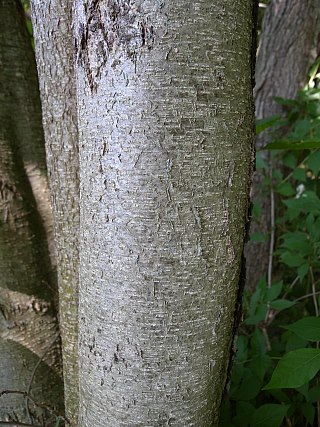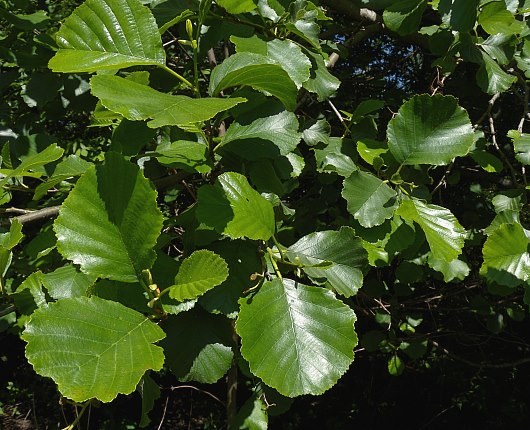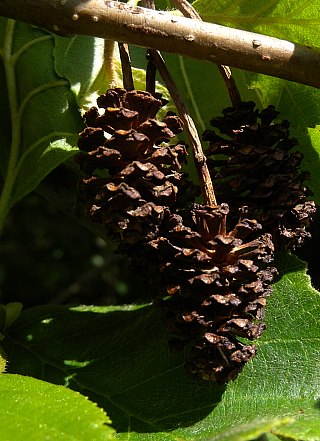Description: This tree is typically 40-70' tall. It has a single or 2-3 trunks and a variably shaped crown. Trunk bark of mature trees is grey or brownish grey, dividing into flattened plates that are separated by broad shallow furrows. The bark of young trees is light gray to greenish gray and more smooth with transverse white lenticels. Alternate leaves up to 5" long and 3½" across occur along the smaller branches and twigs; they are obovate or orbicular-obovate in shape, while their margins are crenate-dentate and slightly undulate. The leaf tips are rounded or slightly indented, while their bases are wedge-shaped (cuneate) to rounded. The upper leaf surface is dark green and glabrous (or nearly so), while the lower surface is more pale and either glabrous or slightly hairy along the undersides of the veins. Young leaves and shoots are often sticky from a resin. The slender petioles are light green, glabrous, and up to 1" long.

Black Alder is monoecious, producing separate male (staminate) and female (pistillate) florets on the same tree. The male florets are produced in clusters of 2-5 catkins. Mature male catkins are 2-3" long, reddish yellow, narrowly cylindrical, and drooping. Within each of these catkins, there are tiny clusters of 3-6 florets that are partially hidden by individual bractlets. Each male floret consists of a 4-lobed calyx and 4 stamens, while each bractlet is oval in shape. The female florets are produced in branching clusters of 2-5 cone-like catkins (less often, occurring as a single catkin). These catkins are initially about ¼" long, but they later become ¾-1" long and ½" across. Within each of these catkins, there are tiny clusters of 2-3 female florets that are partially hidden by individual bractlets. Each female floret consists of a naked ovary with a pair of tiny styles at its apex. The blooming period occurs during the spring before the leaves develop; the florets are cross-pollinated by wind. After the blooming period, the male catkins wither away, while the female catkins persist through the summer, releasing their seeds during the fall. At this time, the bractlets of the cone-like female catkins have become brown and woody; individual bractlets are narrowly oblanceolate with 4-5 short stubby lobes. Individual seeds are obovoid and flattened; their margins are not significantly winged. The female catkins usually persist on the tree through the winter. The root system is woody and branching.
Cultivation: The preference is full or partial sun, moist conditions, and soil containing sandy loam, silty loam, or loam that is acidic to neutral. In some situations, this tree may spread aggressively. Like other species in its genus, Black Alder can add nitrogen to the soil by forming a symbiotic relationship with the bacterium, Frankia alni.

Range & Habitat: Black Alder is uncommon as a naturalized tree in Illinois, occurring in widely scattered areas in the NE, east-central, and southern sections of the state (see Distribution Map). It was introduced into the United States from Europe as a landscape plant. Habitats consist primarily of streambanks and low areas along rivers. Black Alder has been used to control water erosion along streambanks and it is sometimes used to rehabilitate mined land.
Faunal Associations: Insects that feed on Black Alder include a leaf beetle (Calligrapha confluens), larvae of a moth (Caloptilia glutinella), larvae of a sawfly (Fenusa dohrnii), and such scale insects as the Lintner Scurfy Scale (Chionaspis lintneri), Willow Scurfy Scale (Chionaspis salicis), False San Jose Scale (Diaspidiotus ostreaeformis), and Oystershell Scale (Lepidosaphes ulmi). A spider mite (Eriophyes inangulis) forms galls on the leaves of this tree (Clark et al., 2004; Needham et al., 1928; ScaleNet, accessed 2014; Wilhelm & Rericha). Some bird species feed on the seeds or buds of alders (Alnus spp.), including ducks, songbirds, and gamebirds (see Bird Table). These trees also provide protective cover and nesting habitat for many birds; this includes the Rose-breasted Grosbeak, Song Sparrow, Fox Sparrow, Red-winged Blackbird, Rusty Blackbird, Wilson's Warbler, Yellow Warbler, Alder Flycatcher, Willow Flycatcher, Bobwhite Quail, Ruffed Grouse, Wild Turkey, and American Woodcock (the latter bird sometimes nests on the ground in Alder thickets); see DeGraaf (2002), Martin et al. (1951/1961), and Bennett (1900). Mammals that use alder trees for food include the American Moose (twigs), White-tailed Deer (twigs), American Beaver (wood & bark), and Woodland Jumping Mouse (seeds). The Wood Turtle has been observed to feed on the fallen leaves (Martin et al., 1951/1961; Hamilton, 1941; Ernst et al., 1994).

Photographic Location: A streambank at Meadowbrook Park in Urbana, Illinois.
Comments: This introduced tree is larger in size than the native Alnus spp. (Alders) in Illinois, and it is less tolerant of waterlogged conditions. The leaves of Black Alder tend to have fewer veins (7 or less) than those of the native Alders, and their shape tends to be more broad (sometimes nearly orbicular). The scientific name 'glutinosa' refers to the gummy resin that covers young leaves and shoots. Another common name of this species is European Alder.